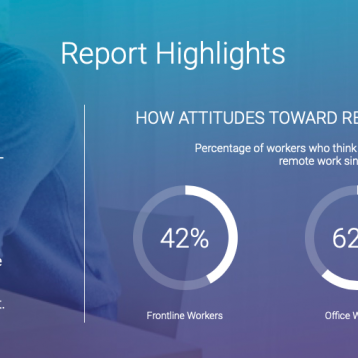- Now that workers are returning to their offices will any of the pandemic practices and experiences be retained? Or is it more: “thank God that’s all over, now let’s get back to work”?
The pandemic has been a fascinating accelerator to working more productively, and new practices are here to stay, including:
-
-
- Inclusivity of remote workers: meetings will remain more inclusive of workers joining remotely; technology is adjusting to blur the lines between multiple participants in a room and individual remote workers to offer a hybrid visual experience.
- Video being the new normal: since the pandemic, people have started to become comfortable with video conferencing technology and cultural expectations of the meeting participants.
- Remote workers feeling more productive: the recent Fuze Flex Study found that for those working remotely full-time, 60 per cent said they are more productive at home than they were in the office. However, this feeling of productivity varies across regions with 70 per cent of Australian respondents saying that they felt more productive versus only 52 per cent of UK respondents.

-
- We have had collaborative technology for more than 20 years and yet it has taken a pandemic to bring it to the forefront. Why?
I believe there are many factors at play with the pandemic bringing collaborate technology to the forefront, including:
-
-
- Culture and technology: The collaboration technology was ready, but driving adoption and cultural change, especially within larger organisations in the enterprise required a forcing factor.
- Trust and outcomes : Leadership and managers needed a breakthrough to build trust in remote work. Work is no longer a place, it is what you do and deliver and employees should be measured on their business outcomes, rather than time spent in the office. The recent Fuze Flex Study found that across all regions, about half (54 per cent) of workers think management is more trusting of remote work, while 70 per cent of senior leaders believe management is more trusting, highlighting a gap between management’s new-found trust in remote work and employee perception of that trust.
-
- The pandemic has wreaked havoc on the travel and hospitality sectors – on the other hand. The cost and environmental benefits are legion. Have attitudes in the business world changed enough to support a universal move to collaborative technology?

I certainly think more companies are open to supporting a universal move to collaborate technology. The pandemic has taught us all how costs can be saved by reducing travel and using that saved travel time for more productive tasks. However, there are several factors which should be taken into account, including:
o Reshaping a company’s culture of video meetings to drive engagement. The recent Fuze Flex Study found that in every industry, every job category, and every region, fewer than 10 per cent of workers consider seeing someone’s face the most critical part of an effective meeting. For workers who report being happier at home, if their day is packed with meetings they become less engaged and productive. In fact, 59 per cent of respondents say they would like to spend less than two hours a day in video meetings. Therefore it is essential that the workforce is not overrun with video meetings every day.
o Burnout and meeting fatigue risks must be taken into account: Companies must establish a structure for the work day to prevent burnout. Only 66 per cent of Fuze Flex study respondents say they are ensuring they take a break every day. In addition, a quarter of respondents report that they find themselves working longer hours since they started working remotely. Communication and productivity tools need to empower workers to disconnect.
- How important is it that collaborative sections are integrated with basic office applications such as spreadsheets, word processors? And drawing tools or is it better to use best in class and rely on the user to deal with the integration?
Integration ecosystems are key to productivity and efficiency. Productivity suites and communication tools must connect with business applications to streamline workflows without compromising user experience; users should not have to ask which application to use. More integrations mean higher adoption and collaboration.







